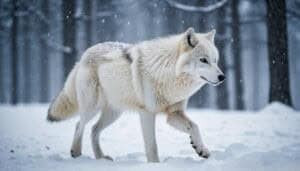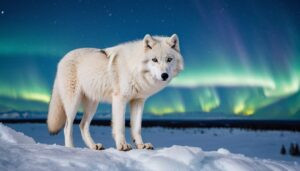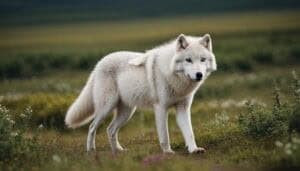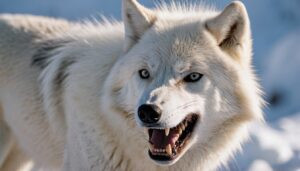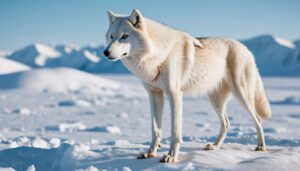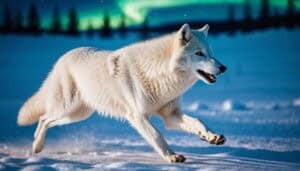Introduction
Understanding the primary muscles used in running for an Arctic wolf provides insight into their incredible endurance and speed
This article delves into the specific muscles that power their movements, from the legs to the shoulders, and explores unique adaptations that enhance their running efficiency. Additionally, we will discuss exercises that help strengthen these crucial muscles
Primary Muscles Used in Running for an Arctic Wolf
Running is a vital aspect of an Arctic wolf’s life, allowing them to hunt, travel, and survive in their harsh environment. The efficiency and power behind their running come from several key muscle groups
Leg Muscles
The leg muscles of an Arctic wolf are critical for propulsion and speed. The primary muscles involved are the quadriceps, hamstrings, and calf muscles:
Quadriceps: Located at the front of the thigh, the quadriceps are essential for extending the knee and providing the forward thrust needed in each stride
Hamstrings: Situated at the back of the thigh, the hamstrings work in tandem with the quadriceps to flex the knee and extend the hip, which is crucial for the push-off phase of running
Calf Muscles: Comprising the gastrocnemius and soleus muscles, the calf muscles are responsible for plantar flexion of the foot, allowing the wolf to push off the ground with power
These muscles must coordinate effectively to enable the Arctic wolf to maintain its speed and agility over long distances
Back Muscles
The back muscles play a significant role in stabilizing and supporting the body during running:
Erector Spinae: This group of muscles runs along the spine and is responsible for maintaining posture and stability. They help to keep the back straight and provide support during the running motion
Latissimus Dorsi: These large muscles on either side of the back assist in the movement of the forelimbs and are crucial for the overall power and stability of the wolf’s stride
A strong back is vital for the endurance required by Arctic wolves as they navigate their expansive territories
Shoulder Muscles
The shoulder muscles are integral to the movement and flexibility of the forelimbs:
Deltoids: These muscles cap the shoulder and are involved in the lifting and swinging of the forelimbs. They provide the necessary range of motion and strength for each stride
Trapezius: Running from the neck down to the mid-back, the trapezius muscles stabilize the shoulder blades and are involved in the movement of the forelimbs
Together, these muscles ensure that the forelimbs can move freely and powerfully, contributing to the overall running efficiency of the Arctic wolf
Abdominal Muscles
The abdominal muscles, although not as visibly prominent, play a critical role in running:
Rectus Abdominis: Known as the “abs,” these muscles help in flexing the spine and stabilizing the torso. They are crucial for maintaining balance and posture during running
Obliques: These muscles, located on the sides of the abdomen, assist in the rotational movement of the body and help maintain stability and balance
Strong abdominal muscles are necessary for the coordination and control required in the dynamic running motion of an Arctic wolf
Hind Leg Muscles
The muscles in the hind legs are particularly powerful, providing the main driving force behind the wolf’s running:
Gluteal Muscles: These muscles in the buttocks are responsible for the extension of the hip and play a key role in the push-off phase of running
Adductors: Located on the inner thigh, these muscles help in stabilizing the leg and guiding the movement during running
The hind leg muscles are critical for generating the powerful thrust that propels the Arctic wolf forward, allowing it to cover long distances swiftly
Muscle Adaptations and Coordination
Arctic wolves have evolved remarkable muscle adaptations and coordination to thrive in their demanding environment. These adaptations not only enhance their running efficiency but also contribute to their overall survival
Unique Muscle Adaptations
Arctic wolves exhibit several unique muscle adaptations that set them apart from other canines:
Increased Muscle Density: The muscles of Arctic wolves are denser than those of other wolves, providing greater strength and endurance. This adaptation allows them to exert more force with each stride, essential for covering long distances in search of prey
Enhanced Fast-Twitch Fibers: Arctic wolves possess a higher proportion of fast-twitch muscle fibers, which are responsible for rapid and powerful movements. These fibers enable quick bursts of speed, crucial for chasing down agile prey
These unique muscle characteristics give Arctic wolves a distinct advantage in their harsh, icy habitats
Muscle Coordination and Running Efficiency
Effective muscle coordination is essential for the running efficiency of Arctic wolves. Their movements are characterized by seamless synchronization of various muscle groups:
Stride Length and Frequency: The coordination of leg and back muscles allows Arctic wolves to achieve long strides with minimal effort. The synchronized contraction and relaxation of these muscles ensure smooth and efficient running
Energy Conservation: By optimizing muscle coordination, Arctic wolves can conserve energy while running. This is particularly important for long-distance travel across their expansive territories, where energy expenditure must be carefully managed
The efficiency of their running mechanics is a testament to the evolutionary fine-tuning of their muscular system
Muscle Fibers in Arctic Wolves vs. Other Canines
The muscle fibers of Arctic wolves exhibit distinct differences when compared to those of other canines:
Fast-Twitch vs. Slow-Twitch Fibers: While Arctic wolves have a higher proportion of fast-twitch fibers for speed, they also maintain a balance with slow-twitch fibers that provide endurance. This combination allows them to sustain long runs without fatigue
Adaptation to Cold: The muscle fibers of Arctic wolves are adapted to function efficiently in cold temperatures. This adaptation includes enhanced blood flow and oxygen delivery to the muscles, preventing stiffness and maintaining performance in freezing conditions
These fiber characteristics highlight the specialized nature of Arctic wolves’ muscular system, tailored for survival in extreme environments
Muscle Contribution to Endurance
Endurance is a critical factor for Arctic wolves, enabling them to travel vast distances in search of food and shelter:
Cardiovascular Efficiency: The muscular adaptations of Arctic wolves are supported by a highly efficient cardiovascular system. This ensures that their muscles receive a continuous supply of oxygen and nutrients, sustaining long periods of physical exertion
Fatigue Resistance: The balance of muscle fibers, combined with optimal coordination, allows Arctic wolves to resist fatigue. This is essential for maintaining speed and agility over extended runs, crucial for both hunting and evading predators
The impressive endurance of Arctic wolves is a result of their finely tuned muscular and cardiovascular systems working in harmony
Strengthening Exercises for Running Muscles
To maintain their peak physical condition, Arctic wolves rely on natural activities and behaviors that effectively strengthen their primary running muscles. These activities mimic the environment in which they live and the behaviors they perform daily
Hunting and Chasing Prey
One of the most critical activities for strengthening the running muscles of Arctic wolves is hunting. This activity requires bursts of speed, agility, and endurance:
Sprints and Short Bursts: During a hunt, Arctic wolves must sprint to catch their prey. This involves rapid acceleration and powerful use of the leg muscles, particularly the quadriceps, hamstrings, and calf muscles. The frequent initiation of sprints helps in developing and maintaining muscle strength and explosiveness
Pursuit Over Long Distances: When prey animals attempt to flee, Arctic wolves often engage in extended chases. This continuous running over long distances enhances the endurance capabilities of their muscles, especially the slow-twitch fibers in the legs and back
The physical demands of hunting are crucial for keeping the wolves’ running muscles strong and resilient
Navigating Varied Terrain
Arctic wolves frequently traverse diverse and challenging terrains, which helps in strengthening various muscle groups:
Climbing and Descending Hills: Moving up and down hills requires significant effort from the hind leg muscles and the back. The gluteal muscles and erector spinae are particularly engaged during these movements, contributing to overall muscle strength and stability
Running on Snow and Ice: The unstable and slippery surfaces of snow and ice demand exceptional balance and coordination. The abdominal muscles, particularly the obliques, are heavily utilized to maintain stability, while the leg muscles adjust to prevent slipping and falling
Navigating these terrains not only builds muscle strength but also improves the coordination and balance necessary for efficient running
Play and Social Interaction
Playful activities and social interactions among Arctic wolves also contribute to muscle strengthening:
Play Fighting: Engaging in mock fights with pack members helps in building muscle strength and flexibility. The shoulder muscles, including the deltoids and trapezius, are particularly engaged during these activities, as wolves wrestle and maneuver
Running and Chasing Each Other: Social play often involves running and chasing, similar to hunting but in a more playful context. This helps maintain muscle tone and endurance without the high stakes of a hunt
These interactions are vital for the overall physical development and well-being of Arctic wolves
Rest and Recovery
While continuous physical activity is crucial, rest and recovery are equally important for muscle strengthening:
Adequate Rest: After intense physical exertion, Arctic wolves need sufficient rest to allow their muscles to recover and repair. This recovery period is essential for building muscle mass and preventing injuries
Nutritional Intake: Proper nutrition supports muscle repair and growth. Arctic wolves rely on a diet rich in protein from their prey, which provides the necessary nutrients for muscle maintenance and development
Balancing activity with rest and nutrition ensures that Arctic wolves can maintain their physical condition and muscle strength
Simulating Natural Behaviors
For Arctic wolves in captivity or those being rehabilitated, simulating natural behaviors can help in maintaining their muscle strength:
Structured Exercise Programs: Implementing exercise programs that mimic natural activities, such as running courses with varied terrains, can help in maintaining muscle strength. These programs should include activities that require sprints, climbs, and play
Enrichment Activities: Providing enrichment activities that encourage natural behaviors, such as hiding food to stimulate hunting instincts, can also contribute to muscle strengthening
These methods help ensure that even in non-natural environments, Arctic wolves can maintain the physical fitness necessary for their survival
Conclusion
The Arctic wolf’s remarkable ability to run swiftly and efficiently is a result of several key muscle groups working in harmony. The leg muscles, including the quadriceps, hamstrings, and calf muscles, provide the primary propulsion needed for running. The back muscles, particularly the erector spinae and latissimus dorsi, offer stability and support
The shoulder muscles, including the deltoids and trapezius, ensure the forelimbs move powerfully and freely. The abdominal muscles contribute to balance and control, while the powerful hind leg muscles, such as the gluteals and adductors, generate the thrust necessary for long-distance running
Additionally, unique muscle adaptations, such as increased muscle density and enhanced fast-twitch fibers, allow Arctic wolves to thrive in their harsh environments. Efficient muscle coordination conserves energy, while the balance of muscle fibers ensures both speed and endurance
Activities like hunting, navigating varied terrains, and playful social interactions naturally strengthen these muscles, supported by adequate rest and proper nutrition
Overall, the muscular system of the Arctic wolf is a testament to evolutionary fine-tuning, enabling these animals to excel in one of the most challenging habitats on Earth. Understanding these muscle dynamics not only highlights their survival prowess but also provides a window into the extraordinary capabilities of Arctic wildlife



